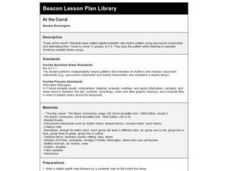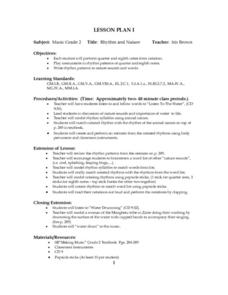Curated OER
AT THE CORRAL
Students study dotted eighth/sixteenth note rhythm pattern using percussion instruments and alternating from "corral to corral" in groups of 4-6. They play the pattern while listening to selected American western theme songs.
Curated OER
Vitamin A
Students identify and pat the beat, move to and play quarter notes, half notes and eighth notes to create a factory movement and instrument improvisation.
Curated OER
Music Mania
For this music worksheet, students identify and locate vocabulary terms related to basic music. There are 23 words located in the puzzle.
Curated OER
SIGHT READING RHYTHM PATTERNS
The perception of rhythms by reading and the ability to auditorily discriminate these rhythm patterns by listening to them performed by the teacher is practiced here. your students will work to create an eight-beat long rhythm pattern.
Curated OER
Music
Third graders sing the Shaker tune "Simple Gifts" while identifying eighth, quarter, and half notes. They listen to Aaron Copland's Appalachian Spring and recall other ballet music.
Curated OER
Can You Compose?
Fourth graders investigate musical notes. In this music lesson, 4th graders compose a short song while clapping the rhythm and singing the syllables using the appropriate notes or rests.
Curated OER
Illustration # 1: Source of Illustration
Students play a game of imitating steady beats by mimicking the instructor. They use drums and repeat the game by echoing rhythmic patterns. The patterns may vary in degree of difficulty according to each individual's ability.
Hawaiʻi State Department of Education
Rhythm Patterns
Fractions can be tricky. Why not have kids think of fractions like they think of eighth, quarter, and half notes? In teams, the class creates four-measure patterns with their percussion instruments. They need to explain their rhythm...
Curated OER
Rhythm, Math, Rhythm
Students play instruments in math class to learn the interconnectedness between math and music. In this math activity, students subdivide a piece of music, clapping rhythms and charting rhythm patterns in the song. A guided discussion...
Curated OER
Body Percussion: Hambone
Students explore body percussion. They practice playing quarter notes and eighth notes separately, then quarter and eighth notes at the same time by different groups. They practice this exercise at different tempos.
Curated OER
Rhythm and Nature
Second graders listen to song "Listen to the Water," discuss nature sounds and importance of water to life, perform quarter and eighth notes from notation, play instruments in rhythm patterns of quarter and eighth notes, and write rhythm...
Curated OER
Teaching Rhythm and Pitch Reading
Students practice correct rhythms and pitches during this short lesson for the middle school instrumental class. Objectives vary depending on music used for the lesson. Students assessed through group playing in class.
Curated OER
Music Accomplished Practice #4
Second graders create their own rhythm with a time signature. They examine notes, rests, and how many beats for ech type of note. Students clap in rhythm. They perform their own rhythm for the class.
Curated OER
VH1 Driven: Kanye West, Lesson 3
Young scholars compose a beat in the style of Kanye West. They listen to and analyze the song, "Through the Wire" by Kanye West, compose a beat, and complete a worksheet.
Curated OER
Jan Ken Pon
Fifth graders explore components of Japanese language, song, instruments, and music. Dotted eighth and sixteenth notes are practiced, the pronunciation of words for the song taught, and chords for tone chimes played in this lesson.
It's About Time
Sounds from Vibrating Air
Take note, or notes, as the case may be. A scientific music lesson is the third in a set of eight covering waves and instruments. Scholars use straws, test tubes, and water to create various wind instruments. Then, they read...
Curated OER
Bravo!!
Second graders study and experiment with rhythm and sound. In pairs, they practice reading and performing simple melodies from sheet music. Individually, they choose one piece to perform for the class.
Curated OER
H1 Classic Presents: Paul McCartney: Chaos and Creation in the Backyard, Lesson 2
Students are introduced to the various songwriting techniques of Paul McCartney. They explore and compare the basic melodic, harmonic, and lyrical tendencies of the different types of pop music.
Curated OER
My Way
Young scholars culminate a humanities project by improvising music to accompany a video of a particular era in US history.
Curated OER
No Title
Third graders assess how to read and write rhythmic notation in music. They explore the concepts of whole, half, quarter, eighth, dotted lines, extended pentatonic, diatonic and major/minor modes. Symbols along with additional...
Curated OER
Chinese Percussion Music
Students investigate Chinese percussion instruments and ensemble performances. They play compositions with Chinese percussion instruments such as small gongs, large gongs and drums.
Curated OER
Poetry Pals
Young scholars create the components for a slideshow featuring their own poetry, illustrations, and music. This lesson uses auditory, visual and kinesthetic (signing and clapping) learning styles.
Curated OER
Rhythm In Motion
Sixth graders work independently and with a partner to demonstrate proficiency of steady beat, meter and basic note values while creating written rhythmic patterns for class performance. State and National Standards are addressed.
SoundTree
Notating Friedrich von Schiller’s Theme to “Ode to Joy.”
To demonstrate their skills with traditional and computer-assisted notation, young musicians notate and perform the first eight measures of Friedrich von Schiller's theme to "Ode to Joy."

























